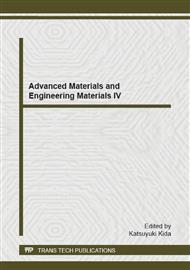[1]
S.V. Karpachev, A.T. Filyaev, Electrochemical kinetics in the case of a solid electrolyte, Elektrokhimiya 2 (1966) 1330-1332.
Google Scholar
[2]
E.P. Murray, T. Tsai, S.A. Barnett, A direct-methane fuel cell with a ceria-based anode, Nature 400 (1999) 649-651.
DOI: 10.1038/23220
Google Scholar
[3]
Y.B. Kim, T.P. Holme, T.M. Gür, F.B. Prinz, Surface-modified low-temperature solid oxide fuel cell, Adv. Funct. Mater. 21 (2011) 4684-4690.
DOI: 10.1002/adfm.201101058
Google Scholar
[4]
B.H. Choi, I.W. Jang, H.J. Sung, Effects of microstructural functional layers on flat-tubular solid oxide fuel cells, Fuel Cells 13 (2013) 1088-1100.
DOI: 10.1002/fuce.201300136
Google Scholar
[5]
S.P. Yoon, S.W. Nam, J. Han, T.H. Lim, S.A. Hong, S.H. Hyun, Effect of electrode microstructure on gas-phase diffusion in solid oxide fuel cells, Solid State Ionics 166 (2004) 1-11.
DOI: 10.1016/j.ssi.2003.10.010
Google Scholar
[6]
L. Zhao, X. Zhang, B. He, B. Liu, C. Xia, Micro-tubular solid oxide fuel cells with graded anodes fabricated with a phase inversion method, J. Power Sources 196 (2011) 962-967.
DOI: 10.1016/j.jpowsour.2010.08.074
Google Scholar
[7]
T. Tsai, S.A. Barnett, Increased solid-oxide fuel cell power density using interfacial ceria layers, Solid State Ionics 98 (1997) 191-196.
DOI: 10.1016/s0167-2738(97)00113-6
Google Scholar
[8]
S.Y. Park, J.H. Ahn, C.W. Jeong, C.W. Na, R.H. Song, J.H. Lee, Ni-YSZ-supported tubular solid oxide fuel cells with GDC interlayer between YSZ electrolyte and LSCF cathode, Int. J. Hydrogen Energy 39 (2014) 12894-12903.
DOI: 10.1016/j.ijhydene.2014.06.103
Google Scholar
[9]
G.B. Balazs, R.S. Glass, Ac impedance studies of rare earth oxide doped ceria, Solid State Ionics 76 (1995) 155-162.
DOI: 10.1016/0167-2738(94)00242-k
Google Scholar
[10]
B.C.H. Steele, Appraisal of Ce1-yGdyO2-y/2 electrolytes for IT-SOFC operation at 500 °C, Solid State Ionics 129 (2000) 95-110.
DOI: 10.1016/s0167-2738(99)00319-7
Google Scholar
[11]
D. Mesguich, C. Aymonier, J.M. Bassat, F. Mauvy, E. You, J.J. Watkins, Low-temperature deposition of undoped ceria thin films in scCO2 as improved interlayers for IT-SOFC, Chem. Mater. 23 (2011) 5323-5330.
DOI: 10.1021/cm2012846
Google Scholar
[12]
W. Lai, S.M. Haile, Impedance spectroscopy as a tool for chemical and electrochemical analysis of mixed conductors: A case study of ceria, J. Am. Ceram. Soc. 88 (2005) 2979-2997.
DOI: 10.1111/j.1551-2916.2005.00740.x
Google Scholar
[13]
C. Sun, U. Stimming, Recent anode advances in solid oxide fuel cells, J. Power Sources 171 (2007) 247-260.
DOI: 10.1016/j.jpowsour.2007.06.086
Google Scholar
[14]
S. He, H. Chen, R. Li, L. Ge, L. Guo, Effect of Ce0. 8Sm0. 2O1. 9 interlayer on the electrochemical performance of La0. 75Sr0. 25Cr0. 5Mn0. 5O3-δ-Ce0. 8Sm0. 2O1. 9 composite anodes for intermediate-temperature solid oxide fuel cells, J. Power Sources 253 (2014).
DOI: 10.1016/j.jpowsour.2013.12.071
Google Scholar
[15]
R.J. Gorte, J.M. Vohs, Novel SOFC anodes for the direct electrochemical oxidation of hydrocarbons, J. Catal. 216 (2003) 477-486.
DOI: 10.1016/s0021-9517(02)00121-5
Google Scholar
[16]
A. Babaei, L. Zhang, S.L. Tan, S.P. Jiang, Pd-promoted (La, Ca)(Cr, Mn)O3/GDC anode for hydrogen and methane oxidation reactions of solid oxide fuel cells, Solid State Ionics 181 (2010) 1221-1228.
DOI: 10.1016/j.ssi.2010.06.042
Google Scholar
[17]
N.M. Sammes, Z. Cai, Ionic conductivity of ceria/yttria stabilized zirconia electrolyte materials, Solid State Ionics 100 (1997) 39-44.
DOI: 10.1016/s0167-2738(97)00306-8
Google Scholar
[18]
X.D. Zhou, B. Scarfino, H.U. Anderson, Electrical conductivity and stability of Gd-doped ceria/Y-doped zirconia ceramics and thin films, Solid State Ionics 175 (2004) 19-22.
DOI: 10.1016/j.ssi.2004.09.040
Google Scholar


